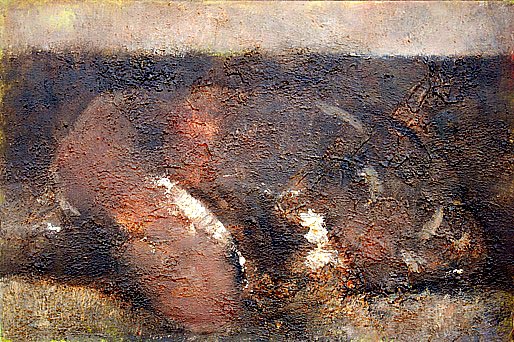Pláč / Lamentations - 80's
_______________________________________________________
The Artists' Deity - The Associations of Helmut Kohlenberger |
| Since the times when Hegel declared the end of art, art itself has become a religion. Of course a special kind of religion. Earlier art had been within the sphere of religion: let us call to mind. the ultimate great works of the Baroque period. It should not be forgotten, however, that the Baroque churches came to resemble the theatre more and more. A fluid transfer?ence took place of the centre of gravity, from cult to ritual, thereby giving rise to the danger of the dissipation of the mystery of cult. But the mystery is making itself known, through a revolution that is "the propagation of death" (Heiner Muller). From that point onwards art has become stigmatised, branded by revolution and by death. Hence it has oriented itself towards the gruesome and the terrible, which this century has grown beyond all imagina?tion. Death has become the deity of the artists.
Let us examine this more closely. Art is so closely bound to religion, to the question of God, that through the radicalisation of religion during the period of revolution, that is through the "humanisation of the divine being" (Hegel), the artistic paradigm has undergone a total transformation. Art has ceased to be the ornamental mantle of cult. The point now was to "observe scientifically" what art is. A strict relation was created between art and science. Both became excellent ways of giving man the opportunity to "reproduce" himself and his world, in the sense of the act of creation. Anyone who wants to must act creatively. But the assumption for this is an absolutely new beginning: the famed "zero hour" of revolution. However, the bestowing upon art of the attributes of science, anticipated in architecture within the revolutionary context of Paris, meant the immediate construction of necropolis. Memorials, cities of the dead, the performance of pageants of mourning - these were the subjects and themes that were to be concentrated on above all, with the use of a language of liberal geometry, technical construction and serial production, which in this century increased all the more. Architecture became the construction of a utopia, and for its model it assumed the swiftest vehicle, the aeroplane. That it was participating in the propagation of death may be seen, for instance, in Le Corbusier envisaging war as the donor of the idea that "war had wrenched the sleepy-heads from out of their slumbers". Thanks to the social acceptance that constructivist art to a large extent enjoys even to this day, art is taking an eminent and direct part in warfare worldwide. Naturally architecture is only one example of this conditioning of art since the times of revolution. Whether art is to agitate on behalf of revolution, or whether it is to be a complaint of the victims in world conflicts, as it is pretty early on in Kathe Kollwitz or Georg Grosz, the context of war remains the predominant one. Together with revolution, as we have said, art is proceeding from a role of accompani?ment to the central role as regards the "humanisation of the divine nature". It is assuming the dimensions of "the Creation of the World" (Kandinsky) that takes place in the work. In this, as Heidegger shows, the "Truth of the Being" comes to the fore, among the contradic?tions of what is patent and what is hidden, what lies latent in language. Through such a radi?cal anchorage of art in truth things of a double nature come to pass: all art becomes a sin?gle language, awaiting truth. By the same token truth becomes ambivalent; what has not been said acquires meaning. Speech (utterance), which has become and art, comes to be the praise of "the lie", as confirmed outright by Picasso, "the artist must know how to con?vince other people of the truthfulness of his lies". Hence speech is faced with an immense test, the extent of which becomes a tangible reality in the aphony of world conflicts. In an art subjected to truth a process takes place of the humanisation of an ever greater aphony, as shown by Kafka's "Trial". A concretely shaped truth in art comes to be trans?posed into the form of ravishment and excess; the nothingness from which the Act of Creation has emerged re-acquires a shape. In the light of this and in anticipation of a cer?tain process, the artist becomes a synonym for "villain". Franz Rosenzweig writes about this that artists are becoming victims in the cause of humanisation. Art anticipates what leads to humanisation, that is to the definition of the nature of humanity. There are many roundabout roads leading up to this. The conclusion is clear; man rubs shoulders with nothingness. That is the secret, that in the ambivalence of real art there takes place the manifestation of humanity, and in it death - the death that surrounds us, of God in man. |

